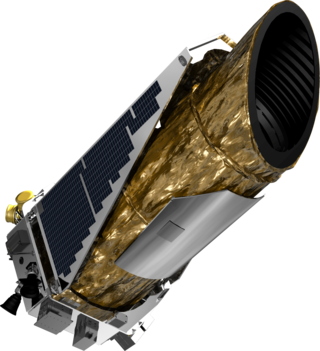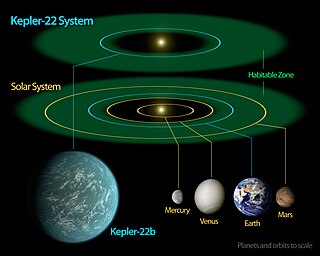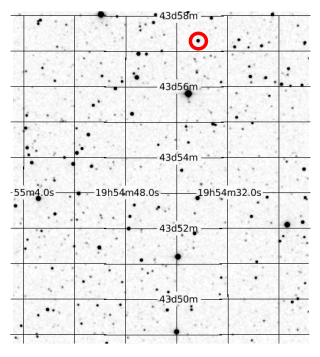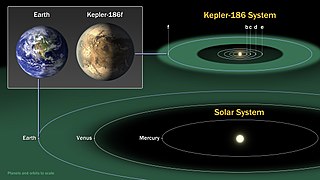Related Research Articles

An exoplanet or extrasolar planet is a planet outside the Solar System. The first possible evidence of an exoplanet was noted in 1917 but was not recognized as such. The first confirmation of detection occurred in 1992. A different planet, initially detected in 1988, was confirmed in 2003. As of 1 February 2023, there are 5,307 confirmed exoplanets in 3,910 planetary systems, with 853 systems having more than one planet. The James Webb Space Telescope (JWST) is expected to discover more exoplanets, and also much more about exoplanets, including composition, environmental conditions and potential for life.

The Kepler space telescope is a disused space telescope launched by NASA in 2009 to discover Earth-sized planets orbiting other stars. Named after astronomer Johannes Kepler, the spacecraft was launched into an Earth-trailing heliocentric orbit. The principal investigator was William J. Borucki. After nine and a half years of operation, the telescope's reaction control system fuel was depleted, and NASA announced its retirement on October 30, 2018.

An exoplanet is a planet located outside the Solar System. The first evidence of an exoplanet was noted as early as 1917, but was not recognized as such until 2016; no planet discovery has yet come from that evidence. What turned out to be the first detection of an exoplanet was published among a list of possible candidates in 1988, though not confirmed until 2003. The first confirmed detection came in 1992, with the discovery of terrestrial-mass planets orbiting the pulsar PSR B1257+12. The first confirmation of an exoplanet orbiting a main-sequence star was made in 1995, when a giant planet was found in a four-day orbit around the nearby star 51 Pegasi. Some exoplanets have been imaged directly by telescopes, but the vast majority have been detected through indirect methods, such as the transit method and the radial-velocity method. As of 1 February 2023, there are 5,307 confirmed exoplanets in 3,910 planetary systems, with 853 systems having more than one planet. This is a list of the most notable discoveries.

Kepler-22b is an exoplanet orbiting within the habitable zone of the Sunlike star Kepler-22. It is located about 600 light-years from Earth in the constellation of Cygnus. It was discovered by NASA's Kepler Space Telescope in December 2011 and was the first known transiting planet to orbit within the habitable zone of a Sun-like star, where liquid water could exist on the planet's surface. Kepler-22 is too dim to be seen with the naked eye.

Kepler-62f is a super-Earth exoplanet orbiting within the habitable zone of the star Kepler-62, the outermost of five such planets discovered around the star by NASA's Kepler spacecraft. It is located about 990 light-years from Earth in the constellation of Lyra.

Kepler-138, also known as KOI-314, is a red dwarf located in the constellation Lyra, 219 light years from Earth. It is located within the field of vision of the Kepler spacecraft, the satellite that NASA's Kepler Mission used to detect planets transiting their stars.

Kepler-186 is a main-sequence M1-type dwarf star, located 178.5 parsecs away in the constellation of Cygnus. The star is slightly cooler than the sun, with roughly half its metallicity. It is known to have five planets, including the first Earth-sized world discovered in the habitable zone: Kepler-186f. The star hosts four other planets discovered so far, though they all orbit interior to the habitable zone.

Kepler-186f is an exoplanet orbiting the red dwarf Kepler-186, about 580 light-years from Earth.

Kepler-438b is a confirmed near-Earth-sized exoplanet. It is likely rocky. It orbits on the inner edge of the habitable zone of a red dwarf, Kepler-438, about 472.9 light-years from Earth in the constellation Lyra. It receives 1.4 times our solar flux. The planet was discovered by NASA's Kepler spacecraft using the transit method, in which the dimming effect that a planet causes as it crosses in front of its star is measured. NASA announced the confirmation of the exoplanet on 6 January 2015.

Kepler-442b is a confirmed near-Earth-sized exoplanet, likely rocky, orbiting within the habitable zone of the K-type main-sequence star Kepler-442, about 1,206 light-years (370 pc) from Earth in the constellation of Lyra.
Kepler-440b is a confirmed super-Earth exoplanet orbiting within the habitable zone of Kepler-440, about 850 light-years (261 pc) from Earth. The planet was discovered by NASA's Kepler spacecraft using the transit method, in which the dimming effect that a planet causes as it crosses in front of its star is measured. NASA announced the confirmation of the exoplanet on 6 January 2015.
Kepler-296e is a confirmed Earth-sized exoplanet orbiting within the habitable zone of Kepler-296. The planet was discovered by NASA's Kepler spacecraft using the transit method, in which the dimming effect that a planet causes as it crosses in front of its star is measured. NASA announced the discovery of the exoplanet on 26 February 2014.
Kepler-296f is a confirmed super-Earth exoplanet orbiting within the habitable zone of Kepler-296. The planet was discovered by NASA's Kepler spacecraft using the transit method, in which the dimming effect that a planet causes as it crosses in front of its star is measured. NASA announced the discovery of the exoplanet on 26 February 2014.
Kepler-395c is a potentially habitable exoplanet 616 light-years away in the constellation of Cygnus.

Elisa Victoria Quintana is a scientist working in the field of astronomy and planetary science at NASA Goddard Space Flight Center. Her research focuses the detection and characterization of exoplanets in addition to studying how they form. She is best known for the detection of Kepler 186f, the first Earth-sized planet found in the habitable zone of a star other than the Sun.

TRAPPIST-1g, also designated as 2MASS J23062928-0502285 g and K2-112 g, is an exoplanet orbiting around the ultra-cool dwarf star TRAPPIST-1 40 light-years away from Earth in the constellation Aquarius. It was one of four new exoplanets to be discovered orbiting the star using observations from the Spitzer Space Telescope. The exoplanet is within the optimistic habitable zone of its host star. It was found by using the transit method, in which the dimming effect that a planet causes as it crosses in front of its star is measured.
Kepler-1652b is a super-Earth exoplanet, orbiting within the habitable zone of the red dwarf Kepler-1652 about 822 light-years away in the Cygnus constellation. Discovered by NASA's Kepler spacecraft, Kepler-1652b was first announced as a candidate in 2013, but wasn't validated until four years later in 2017. It is a potential super-Earth with 160% Earth's radius. The planet orbits well within the habitable zone of its system, the region where liquid water can exist on a planet's surface. The planet is an eyeball planet candidate.
Kepler-160 is a main-sequence star approximately the width of our Galactic arm away in the constellation Lyra, first studied in detail by the Kepler Mission, a NASA-led operation tasked with discovering terrestrial planets. The star, which is very similar to the Sun in mass and radius, has three confirmed planets and one unconfirmed planet orbiting it.
References
- 1 2 Quintana, E. V.; Barclay, T.; Raymond, S. N.; Rowe, J. F.; Bolmont, E.; Caldwell, D. A.; Howell, S. B.; Kane, S. R.; Huber, D.; Crepp, J. R.; Lissauer, J. J.; Ciardi, D. R.; Coughlin, J. L.; Everett, M. E.; Henze, C. E.; Horch, E.; Isaacson, H.; Ford, E. B.; Adams, F. C.; Still, M.; Hunter, R. C.; Quarles, B.; Selsis, F. (18 April 2014). "An Earth-Sized Planet in the Habitable Zone of a Cool Star" (PDF). Science . 344 (6181): 277–280. arXiv: 1404.5667 . Bibcode:2014Sci...344..277Q. doi:10.1126/science.1249403. PMID 24744370. S2CID 1892595.
- 1 2 Johnson, Michele; Harrington, J.D. (17 April 2014). "NASA's Kepler Discovers First Earth-Size Planet In The 'Habitable Zone' of Another Star". NASA. Archived from the original on 17 April 2014.
- 1 2 Bolmont, Emeline; Raymond, Sean N.; von Paris, Philip; Selsis, Franck; Hersant, Franck; Quintana, Elisa V.; Barclay, Thomas (16 April 2014). "Formation, tidal evolution and habitability of the Kepler-186 system". The Astrophysical Journal. 1404 (1): 4368. arXiv: 1404.4368 . Bibcode:2014ApJ...793....3B. doi:10.1088/0004-637X/793/1/3. S2CID 118709918.
- ↑ Rowe, Jason F.; Marcy, Geoffrey W.; Lissauer, Jack J.; Jontof-Hutter, Daniel; Mullally, Fergal; Gilliland, Ronald L.; Issacson, Howard; Ford, Eric; Howell, Steve B.; Borucki, William J.; Haas, Michael; Huber, Daniel; Steffen, Jason H.; Thompson, Susan E.; Quintana, Elisa; Barclay, Thomas; Still, Martin; Fortney, Jonathan; Gautier, T. N.; Hunter, Roger; Caldwell, Douglas A.; Ciardi, David R.; Devore, Edna; Cochran, William; Jenkins, Jon; Agol, Eric; Carter, Joshua A.; Geary, John (27 February 2014). "Validation of Kepler's Multiple Planet Candidates. III: Light Curve Analysis & Announcement of Hundreds of New Multi-planet Systems". The Astrophysical Journal. 784 (1): 45. arXiv: 1402.6534 . Bibcode:2014ApJ...784...45R. doi:10.1088/0004-637X/784/1/45. S2CID 119118620.
- ↑ Glister, Paul (5 November 2013). "Earth-Sized Planets in Habitable Zone Common". Centauri Dreams. Archived from the original on 19 April 2014. See comment by "Holger 16 November 2013 at 14:21".
^redakce ["editor"] (6 August 2013). "Kepler (asi) našel obyvatelnou planetu o velikosti Země" [Kepler (probably) found a habitable planet the size of Earth] (in Czech). exoplanety.cz. Archived from the original on 20 August 2013.{{cite web}}:|author=has generic name (help)
^ "Kepler: Erster Kandidat einer habitablen Exoerde Veröffentlicht" [Kepler: First candidate of a habitable Exoplanet Published]. Zauber der Sterne [Magic of the stars] (in German). 19 August 2013. Archived from the original on 27 September 2013.
^Bovaird, Timothy; Lineweaver, Charles H. (1 August 2013). "Exoplanet Predictions Based on the Generalised Titius-Bode Relation". Monthly Notices of the Royal Astronomical Society. 435 (2): 14–15. arXiv: 1304.3341 . Bibcode:2013MNRAS.435.1126B. doi:10.1093/mnras/stt1357.

